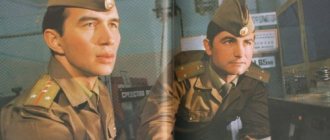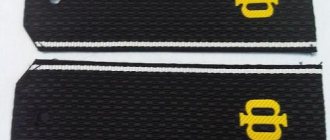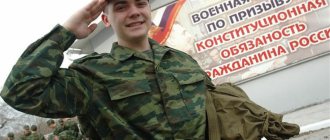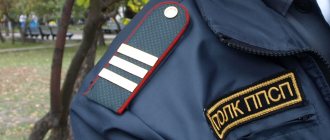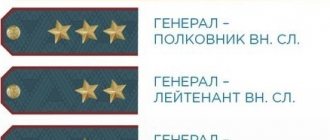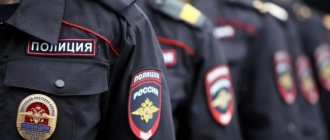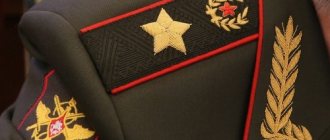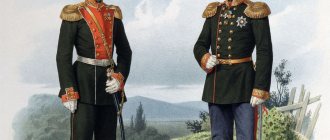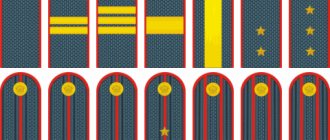Do you know how many stars are on the shoulder straps of an ensign, lieutenant or army general? Read the article and learn about all the meanings of shoulder straps.
Men who decide to serve their Motherland try to receive stars every year and achieve other titles. A military man wins, conquers new heights, and therefore only a real man can have this calling. These are the character qualities that attract women, and military clothing is considered a kind of symbol of the defender of the country and family warmth. With a military man, every lady feels protected.
What are the shoulder straps of a serviceman? Where are the stars on them, how do the weather differ from each other?
The history of the origin of shoulder straps and ranks in the Armed Forces of the Russian Federation
If we look at the historical origins, then initially there were no military differences at all. For the first time in Ancient Rus', the standing army was divided into separate formations. Formations were built according to the number of people. For example, ten warriors were called "ten". The head of such a unit was called "ten's". Other formations were built on the same principle.
This system was subsequently changed several times. Under Ivan the Terrible, new units appeared. They were called "hundreds". Military ranks appeared for the first time in the Streltsy hundreds. At that time the ranks were as follows:
- Sagittarius. Compared to the modern army, this is a private.
- Foreman. In our time, this is a sergeant or sergeant major.
- Pentecostal. Now this rank would be equivalent to the rank of lieutenant.
- Centurion. The modern rank is captain.
- Head.
The following hierarchy changes were extended. New ranks have appeared:
- Soldier;
- Corporal;
- Ensign;
- Lieutenant or Lieutenant;
- Captain or captain;
- Quartermaster;
- Major;
- Lieutenant colonel;
- Colonel.
In 1654, the new rank of general was awarded for the first time. Alexander Ulyanovich Leslie was the first to receive it in Russia. He led the liberation of Smolensk. And he received this title for courage and services to the Fatherland.
Shoulder straps from the times of the Soviet Union
In the twenties of the last century, the military uniform replaced epaulettes with shoulder straps of the modern type, which the Russian army still uses. Since then, a hierarchy has also appeared in the Russian army, which has survived to this day.
For example, one star on the shoulder straps meant that the serviceman had the rank of warrant officer, but if the soldier had two stars, then he was a major , if there were three, then the serviceman was promoted to the rank of lieutenant colonel , and if there were four, then he was a staff captain.
Five stars mean that the serviceman has the highest military rank. If this concerns ground forces, then this is a field marshal, and if this concerns naval forces, then it is an admiral of the fleet . However, five stars are not sewn on his shoulder straps; they are replaced by one large one and the coat of arms of the Russian Federation (in the modern interpretation).
However, in those days, epaulettes had not yet completely disappeared from military uniforms, since they were worn by colonels. And just like in the distant tsarist times, they did not have such insignia as stars. They came into common use on military uniforms only after another reformation took place in Soviet times, which led to the fact that soldiers began to wear overcoats.
In addition to stars, the Soviet army began to use brass buttons In addition, emblems were used that demonstrated the insignia of a particular branch of the military. Since then, the military uniform has acquired the form that is used to this day.
Shoulder straps in the Armed Forces of the Russian Federation
Shoulder straps, like military ranks, vary. Shoulder straps have a distinguishing number of criteria, such as: the color of the shoulder straps, the order of the distinctive signs on the shoulder straps themselves, the color of the distinctive signs.
Another criterion is the uniform of Russian military personnel. There are three types of uniforms in the army, namely: casual, field and dress.
On the everyday uniform of non-officer Russian military personnel there are shoulder straps with two narrow stripes along the edges of the longitudinal part of the shoulder strap.
On the uniform of officers of Russian military personnel there are three more types of shoulder straps for everyday uniforms:
- Shoulder straps for junior officers of the Russian army: have one stripe located in the center along the shoulder strap itself.
- Senior officers of the Russian army: wear shoulder straps with two longitudinal stripes located in the center of the shoulder strap.
- The shoulder straps of senior officers of the Russian army have a fabric relief along the entire shoulder strap. The edges of the shoulder strap are framed by a narrow stripe. The stars follow strictly in one row.
- The Marshal of the Russian Federation has shoulder straps with fabric relief and they are distinguished by their gold color.
The field uniform of Russian military personnel requires wearing different shoulder straps. Consider these shoulder straps:
- The shoulder straps of non-officers of the Russian army are a regular rectangle, camouflaged in the color of the summer taiga with a longitudinal stripe.
- The field uniform of junior officers of the Russian army requires wearing shoulder straps with relatively small dark green stars.
- Senior officers of the Russian army wear shoulder straps on their field uniforms with large stars.
- The senior officers of the Russian army have identical shoulder straps with stars located strictly in one row.
- The General of the Army and Marshal of the Russian Federation have shoulder straps with large gold stars.
How epaulets were born
Even during the period when Peter I was the ruler of Russia, such an element of the uniform of soldiers and military personnel as shoulder straps began to enjoy a certain popularity. Initially, they were a subject of appearance exclusively for soldiers, but later the rule of wearing shoulder straps reached the officers.
However, in those days there were no distinctive signs, so they did not fulfill their original function today, that is, it was impossible to judge the rank of a serviceman by how many stars he had on his shoulder elements, since they simply had not yet been introduced .
Subsequently, this problem was partially solved, since the shoulder straps of each individual battalion or regiment had its own, individual colors. Each unit wore a uniform that was significantly different in color spectrum from the other.
For example, military officers used hexagonal shoulder straps
During the times of Tsarist Russia, shoulder straps had a variegated coloring; silver and golden tones were often used to distinguish him from other employees. This type of shoulder strap spoke of the high rank of this serviceman, which should have evoked in others a feeling of respect and admiration at the same time.
However, such distinctive general symbols were used before the revolution of the 17th year began, after which the military uniform and, accordingly, shoulder straps underwent certain reformations. At first, this shoulder element was completely abolished, since the then established Soviet government considered them too pretentious, alien and hostile to the Russian spirit and traditions.
For this reason, shoulder insignia as such did not exist for generals and soldiers until the onset of 1943; ranks were determined by buttonholes on the collar.
How is selection for a military educational institution carried out?
Before starting a military career, a future soldier must meet certain standards. These include the following:
- how fit the future cadet is for military service (the health factor is taken into account);
- how physically developed and prepared the candidate is for future tests;
- it is necessary to determine how objective the potential soldier’s decision to join the army was (the psychological factor, as well as the character and knowledge of the person, are taken into account here);
- Points that were obtained based on the results of state certification after graduating from school or college are also taken into account.
cadet shoulder straps almost immediately along with a military uniform, and at the same time they assume certain obligations. For example, in the air force of our country it is stipulated that a cadet must have the following skills:
- during training he must master a specific type of aircraft, and the total number of flight hours must not be less than 170 hours;
- during the training process, the cadet is required to master any specific combat vehicle, as well as learn to drive it (the total number of driving hours should not be less than 250);
- In addition, during the training process, the cadet is required to make at least 30 parachute jumps, regardless of weather conditions.
What do stripes on shoulder straps mean?
It is necessary to distinguish between a gap and a strip. Clearance is a straight line running along the entire length of the shoulder strap. The color is not the same in different branches of the military. A stripe is a badge of rank in the form of a transverse strip attached to the shoulder straps of junior military personnel.
Both gaps and stripes help to determine the rank of the employee wearing the shoulder straps. In the army, they are necessary for a clear understanding of what duties the employee is required to perform. A military man of higher status has more obligations and greater responsibility.
Important! In fact, it is correct to say stripe, not stripe.
What does 1 stripe on shoulder straps mean?
The soldiers have the only badge on their shoulder strap:
- corporal (one narrow strip);
- senior sergeant (wide stripe).
Among the officers, shoulder straps with one gap are worn by junior officials:
- junior lieutenant (one star attached);
- lieutenant (two stars);
- senior lieutenant (three);
- captain (four).
Important! In the Navy, the division of responsibilities is similar, only the ranks are called differently.
Let's take a closer look at representatives of which Russian army positions are entitled to shoulder straps with one stripe.
Titles with one badge
| Type of troops | Narrow stripe | Wide stripe | Big stripe |
| Ministry of Internal Affairs (police, Ministry of Emergency Situations) | Senior Police Sergeant | Police sergeant | |
| NE (land) | Corporal | Staff Sergeant | Sergeant Major |
| VKS and Airborne Forces | Corporal | Staff Sergeant | Sergeant Major |
| Navy (navy) | Senior sailor | Chief Petty Officer | Chief petty officer |
Modern shoulder straps
As a rule, depending on where the serviceman is sent, the color scheme of his shoulder straps , and sometimes the shade of the major’s star, may change slightly.
The ceremonial uniform of a military man includes shoulder straps , and the color of the edging can be different depending on which troops the major . For example, if these are ground forces, then the border is red, and if they are air forces, then the border is blue.
In the appearance of the military uniform there are stars not only of the classic dark green color, but also of protective shades. Currently, metal stars tend to have smoothed edges. In addition, there is now an additional innovation in the form of false shoulder straps. They differ from standard ones in that stars are not attached to them, as is usually the case, but are painted with special paint. Other elements that are located near the shoulder straps or directly on them can also be painted with this paint.
As a rule, false shoulder straps are used specifically in the field, since this way the stars will not fly off or come off the shoulder straps . Sewn-on stars are used at special events, such as parades. Also, false shoulder straps are of strategic importance for major or other ranks of military personnel. The fact is that metal stars can reflect the sun's rays, and for this reason a soldier can simply betray his presence and the presence of his comrades to the enemy.
